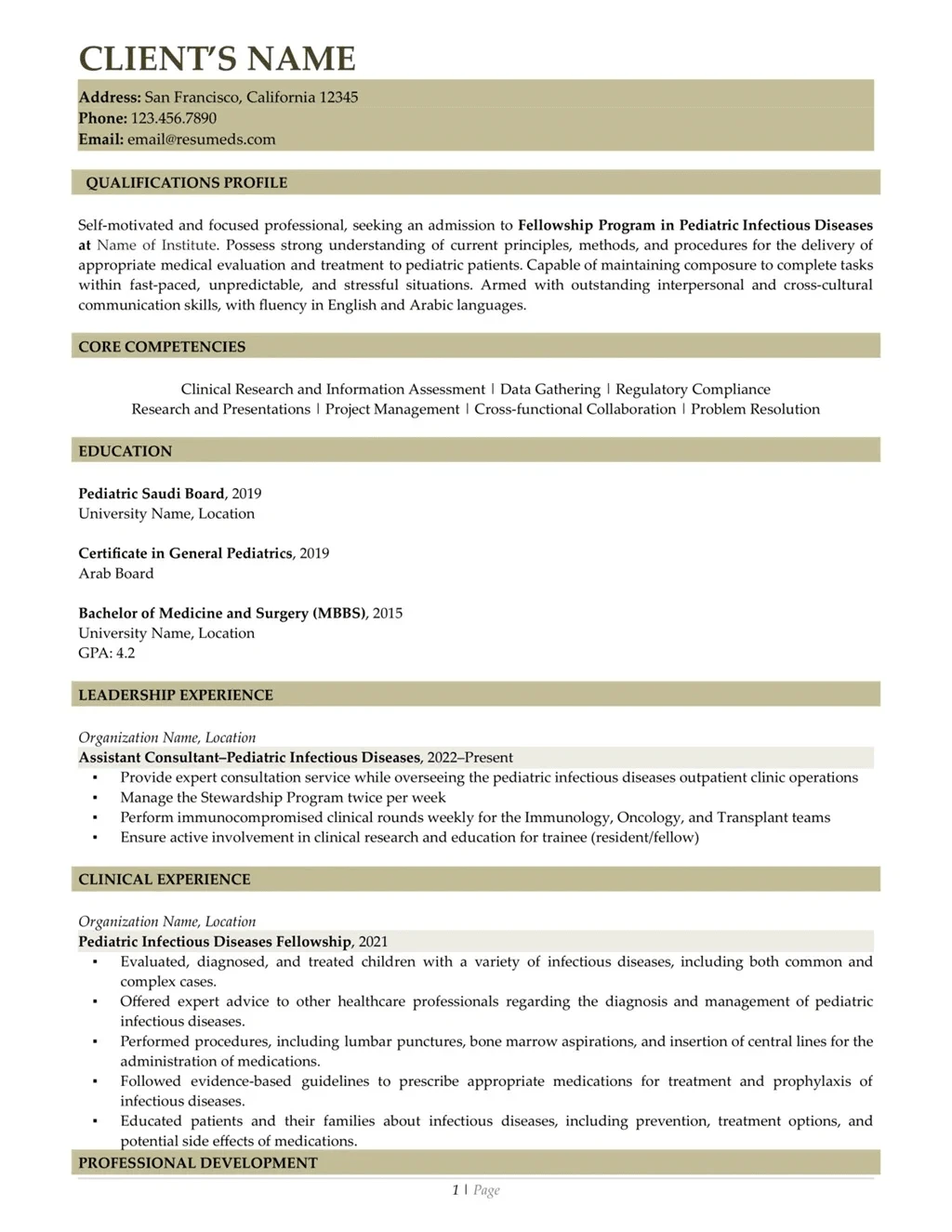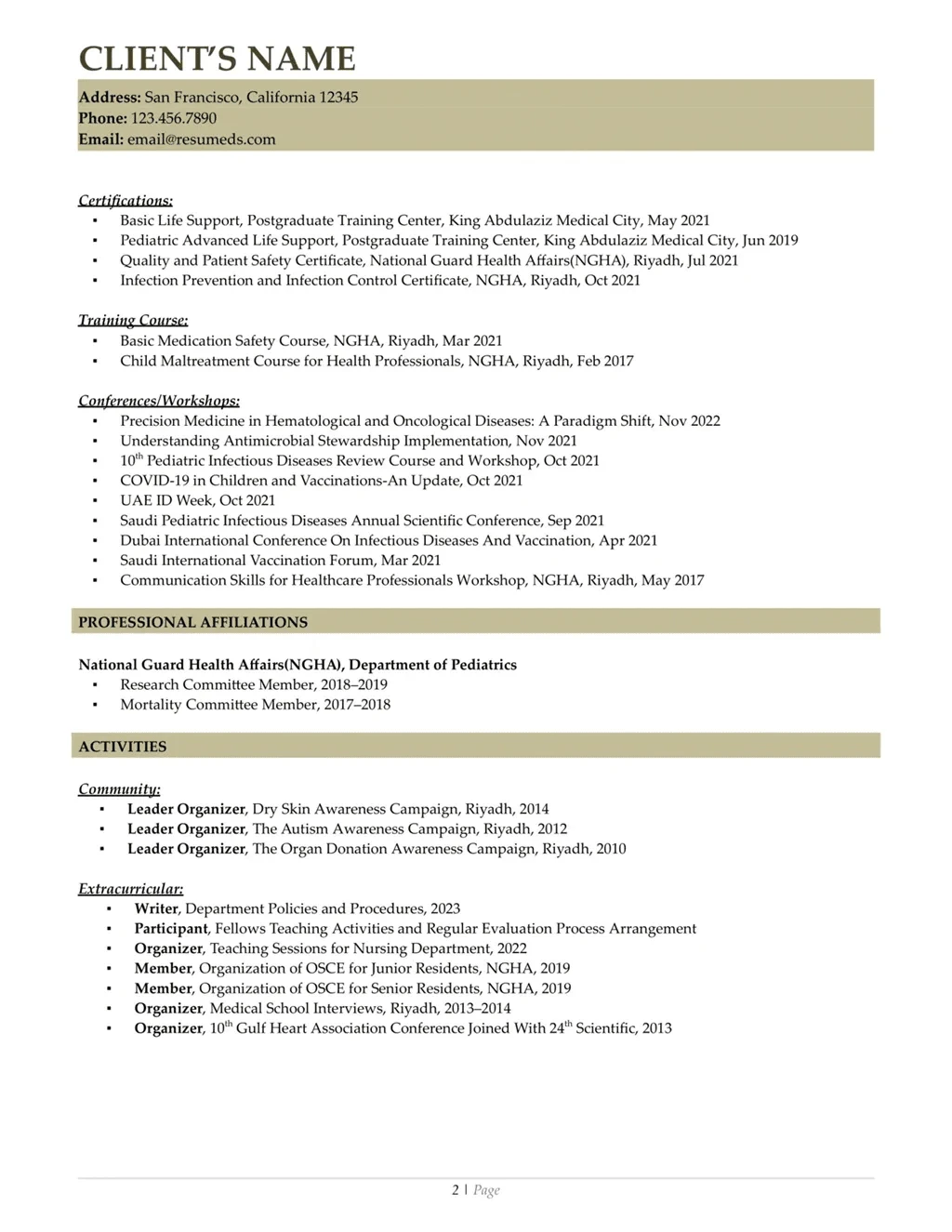Applying to medical school is a necessary step for anyone wishing to enter the medical industry, both academically and professionally. And one important component that can support your application is a medical school resume, a document that summarizes your qualifications, experiences, and accomplishments. With the use of this tool, you have a better chance of securing a position in any competitive medical program.
And if you’re curious about how to create a strong medical school resume, then keep reading. We’ll talk about the importance of a medical school resume and show you how to draft a medical school application that highlights your ability as a future medical practitioner.
What is a Medical School Resume?
A medical school resume is an application document that succinctly outlines your educational background, experiences, volunteer work, research initiatives, and other noteworthy activities that are primarily used for medical school program application. This type of resumes, in contrast to standard application tools that are customized for specific job tasks, are meant to give admissions committees a straightforward yet detailed overview of a candidate’s abilities that show why they are a good fit for a medical career.
Some medical schools may ask for this kind of resume expressly as part of their application criteria, while others might just give candidates the choice to submit one. However, if you want to make your application stand out, a strong medical school resume is a great asset.
How to Put Medical Degree on Your Medical School Resume
Where to put the medical degrees or education attainment is a common question when preparing a medical school resume. Many job seekers believe that it’s a safe bet to follow the same guidelines in a traditional resume in placing the education section.
What they might not know, though, is that a medical school resume’s education or medical school is usually located at the top of the application. And unlike in a traditional resume where education information is briefly summarized, this area of a medical resume tends to be more comprehensive. It often includes residency and fellowship experiences that are pertinent to the candidates’ field of specialization.
In addition to including your medical school education on your resume, there are two more crucial pieces of information you should be aware of in order to write a standout school application.
Can You Add a Photo to Your Medical School Resume?
In the US and Canada, it is discouraged to include a photo with your resume for medical school application. Instead of focusing on appearance, admissions committees prioritize qualifications and experiences. Plus, including a photo may also invite unconscious bias, which schools aim to prevent. Therefore, it’s better to stick to the conventional format that avoids photographs unless specifically stated in the school application requirements.
What Kinds of Experiences Impress Medical Schools?
Usually, medical schools look for candidates who have a strong commitment toward the medical or healthcare field, academic distinction, and a well-rounded personality trait. But other than this, the following types of experiences can help your medical school resume stand out:
Clinical Experience
Your practical clinical experience demonstrate your exposure to the medical industry. What this means is that adding your experience working as a medical scribe, volunteering at a hospital, or shadowing doctors will give you an edge on the program.
Research Projects
Engaging in scientific or medical research can also make a big impact on your medical school application. For that reason, if you join any of these projects — whether it be an individual project or a mapping group — make sure to detail your role and responsibilities to impress the admission committee.
Leadership Experience
In medical school, leadership positions are also highly valued. This is due to the fact that assuming leadership roles in groups, clubs, or charitable organizations also speaks of your teamwork and leadership. Thus, be sure to highlight your leadership duties in pertinent organizations or volunteer work in this section.

How to Write a Medical School Resume
Many people struggle to create a medical school resume due to the extensive and precise process involved in including all the necessary information in one document. Thus, we have come up with a comprehensive guide to assist you in creating a strong school application:
1. Put your contact information at the top of your medical school resume.
Write your whole name in a font size that is slightly larger than the rest of the text. Then, below your name, include your phone number and email address, as well as the links to your LinkedIn profile and personal sites.
2. Give a brief overview of your qualifications and future goals by creating an impressive resume summary.
Grab the attention of the admissions committee by writing your professional summary. Make sure to emphasize the key qualities that set you apart from the competition, such as your love of medicine, your devotion to patient care, and passion for continuous learning.
3. List skills that are applicable to the school program or medical career.
In this section, highlight your medical skills and proficiency in laboratory techniques and medical language, along with other soft skills like communication, empathy, teamwork, and problem-solving to showcase both your good traits and industry expertise.
4. Detail your recent education in both medical and non-medical courses.
List your education, including the institution’s name, address, degree obtained including major and minor), and GPA. You may also want to include any academic distinctions or accolades you have won in this section, such as scholarships or recognition on the Dean’s List to add more value.
5. Make a separate section to showcase any licenses or certificates.
If you have any, showcase licenses or certification relevant to the field on your medical school resume. This could include any pertinent certifications, such as CPR, first aid, or medical assisting certifications. Give the certification’s name, the name of the granting body, and the expiration date.
6. Include your work experience.
Don’t forget to outline your work history, including professional, internship, volunteer, and research experiences. Discuss your tasks and responsibilities using bullet points, while highlighting any quantifiable results or accomplishments. Moreover, ensure that it showcases your enthusiasm for medicine, aptitude for leadership, and ability to function in a variety of settings.
7. Mention any professional associations you belong to.
Give the name of the group, your membership status, and participation in these groups to show that you are dedicated to the field and that you want to keep up with developments and trends in the sector.
8. Lastly, add important sections as applicable.
If you have additional academic achievements, extracurricular activities, or relevant interests that will improve your application, consider adding extra sections to showcase them. These could include awards, scholarships, or publications in scholarly journals, or participation in medical mission trips that set you apart from other applicants.

How Long Should a Medical School Resume Be?
Ensuring your medical school resume covers all significant aspects of your background is essential to grab the admissions committee’s attention. But just because it needs to give a complete picture of your qualification doesn’t mean you have to add every detail, even if it’s not necessary. A medical school resume, like any resume, should be concise and focused on highlighting your most relevant experiences, skills, and achievements.
Typically, it’s recommended to keep it to one page, especially for applicants with limited work experience or recent graduates. Nevertheless, if you have extensive relevant experience, such as research, clinical work, or publications, you may extend it to two pages, but make sure every detail is pertinent to your application.
Related Article:
Healthcare Resume Tips: How Long Should a Resume Be?
Medical School Resume Example
Interested in learning how a resume for medical school is different from a regular one? Check out this medical school resume example crafted by one of our experts and discover the straightforward way to write a medical student resume:


Download a copy of this medical school resume example.
Have a Compelling Medical School Resume with the Help of Professionals
A compelling medical school resume is vital to the success of your medical school application. So, be sure to create one that successfully showcases your expertise and strengths by following the tips and using the accompanying medical school resume example above as a reference.
Still, if you truly want to stand out from the competition don’t leave your medical school resume up to chance; instead, get expert help from ResuMeds. Our expert medical school resume writers can greatly help you present your qualifications in the best light. Additionally, they have all the expertise that can help you increase your chances of being accepted. So, contact us today!







